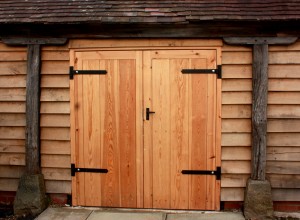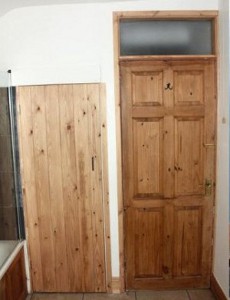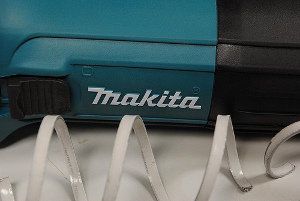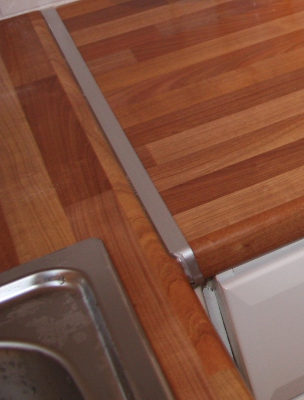How to choose a wooden door
There are various things to consider in choosing an internal or external wooden door. Here are our five ‘Fs’ for picking the right type of wooden door.
Form (design)
Firstly think about the design of door that you want – consider the age of your property and what doors are already fitted. If your house is listed you will need Listed Building Consent to add or replace a door – check with your local council. There are various types of wooden door to choose from:
Paneled
The traditional wooden door of town houses. The door is constructed of solid wood or plywood panels grooved into vertical stiles, horizontal rails and often with intermediate vertical members (muntins) – all jointed with mortice-and-tenon joints or dowels. Glass vision panels can also be incorporated. These are classic, solid doors.
Boarded
Often used in barn conversions and country homes. These are either ‘framed ledged & braced’, ‘ledged & braced’, or simply, ‘ledged’. Tongue & grooved boarding is fixed to the face of this framing. They are a cost-effective solid wood option that are easily made for any size of space.
Flush
Commonly used in modern properties, these are flat in appearance. They are usually made of a softwood inner frame, faced each side by a plywood or hardboard skin. The core maybe cardboard egg-crate or fibreboard. Basic quality flush doors are cheap and ideal for modern properties. Solid core doors veneered in hardwood will be expensive.
Moulded
These look like panel doors but are made like flush doors. They have a moulded or embossed veneer that is often made of MDF and is stuck on to a wooden or composite frame. These are lighter than solid wooden doors and give you a period look at less cost.
Function (use)
Your choice of door should relate to what you want to use it for. An exterior door or one for heavy use, should be more solid and durable in construction than a door designed for internal or light use. A paneled or boarded door is often used externally, being more weather and intruder resistant than a Flush or Moulded door. Internal doors are usually 32mm or 44mm thick, while external and fire doors are commonly 44mm or more. For domestic properties, fire doors are necessary if the property is over two stories high. Fire doors are rated from 30 minutes (FD30) to 120 minutes (FD120) and come in different designs. Check the label on a fire door, frame and seal to ensure that you choose the correct door specified by the building regulations. Large doors may need to be made out of lighter material or the door frame may need strengthening for it to bear the weight. A ledged and braced door is a good choice for a large doorway.
Fabric (material)
The materials used to make the door will affect its cost, durability, security, appearance and fire rating. As a general rule, the more solid wood and harder the timber used in a wooden door, the more durable, robust and expensive it is likely to be. Composite doors with little real or hardwood tend to be cheaper and lighter, but are less hard wearing and secure. In terms of appearance, you cannot beat a hardwood door. Hardwoods are darker than softwoods; they maybe required to match exiting doors in listed properties. Fire doors usually have a fire resistant coating or core and are more expensive than similar standard doors. Some hollow doors cannot be trimmed and are therefore unsuitable for irregular spaces. Standard ‘Imperial’ door sizes are 1981, 2032 or 2040mm high by 686, 762, 813 or 838mm wide. If you need a non-standard door, flush door blanks are available and can be trimmed to size – otherwise you will need a joiner to make you custom door.
Fitting (hanging)
A door is usually fixed to a door lining or frame with hinges or sliding door gear. The standard door hinge is a single axis hinge. The weight of the door should be checked against the maximum load-bearing capacity of the hinge. For fire doors, steel or stainless steel hinges must be used and expanding intumescent (smoke strips) are usually recessed into a groove in the door or frame. For Boarded doors, long strap hinges are attractive and can be fixed to the back or front. If there is sufficient clearance (door-opening space) next to a door but not in front of it, a sliding door could be used. These are fixed to sliding door gear above the door and a guide at the floor prevents it from moving laterally. The track will usually be boxed in for aesthetics. Flush and Moulded doors may have a lock block for fitting a lock and will need to be hung the right way round.
Furniture (handles etc)
As well as hinges, think about handles, locks and automatic closing or opening devises. There is a wide choice of handles, knobs, pulls and latches in a variety of metals and finishes. Brass, stainless steel and steel are commonly used metals. Finishes include polished, satin, chrome, pewter, brushed and antique. It is worth considering buying reclaimed handles to match door furniture in period properties. Fire doors will need automatic closing devices fitted. These can be visible, like overhead fixed-face closers, or concealed, like spring hinges. In commercial properties, double fire doors will need a door coordinator devise to ensure that the doors close in the right sequence. Push bars may be needed on fire exits, and hold-open devises can be wired-up by a qualified electrician. Before choosing a door lock, check the requirements of your insurance. Most firms require 5 lever mortice locks to be used on external doors. A reinforcing metal door frame strip, door limiter, hinge bolts and spy hole can also be fitted to external doors for added security.
That’s our 5 tips on choosing a wooden door. We could have added an extra ‘F’ on ‘finish’ – what paint or stains you could use – but that would be straying into the territory of painters and decorators! For wooden doors or door hanging in Shropshire, do contact Oliver Gibbs Carpentry and joinery for advice or a free quote.






0 Comments